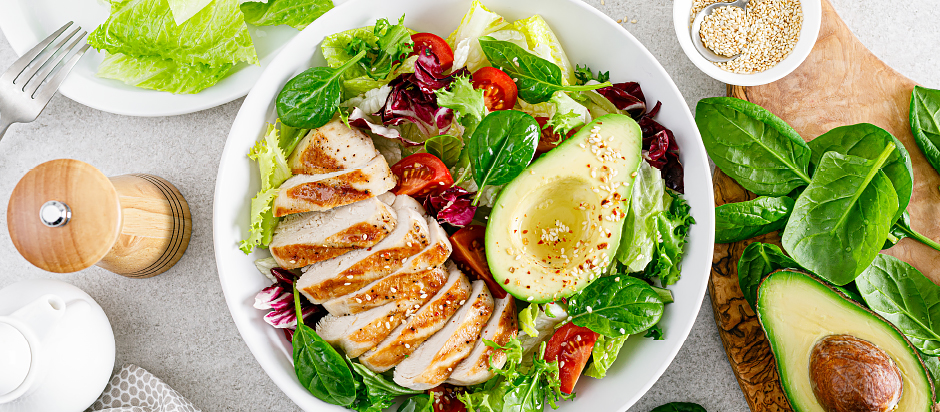5 Ways to Spring Clean Your Diet
After the heavy comfort foods of winter, April arrives with the perfect opportunity to spring-clean your diet. Just as you’d clear clutter from your home, spring is the ideal time to sweep away unhealthy eating patterns and cultivate fresh, nutritious habits. These five simple tips will help you reset your diet for the vibrant months ahead while honoring the seasonal bounty that spring brings to our tables.
Mix Up Your Menus
Fire up the grill this spring and make tender, juicy pork chops; delicious, lean meat packed with flavor perfect for healthy cooking. Pork chops are low in fat, high in protein, and contain more vitamin B than some other meats. Try our Grilled Pork Chops recipe. The lemon-rosemary rub adds a vibrant flavor to the chops. This grilled pork chops recipe is an excellent choice for adding to salads and the Easter menu if you want an easy yet memorable meal for the holiday dinner table.
Asparagus is a highly anticipated spring vegetable for its unique flavor and versatility. Young, delicate asparagus makes a tasty addition to scrambled eggs, while thick asparagus is terrific when roasted and added to pasta dishes. Make a Grilled Asparagus Salad to complement grilled chicken or steak. The spears get tender, smoky, and sweet when grilled. Asparagus is an excellent source of vitamins A, C, and K and dietary fiber. And it’s low in calories; one medium-sized spear of asparagus is only about three calories.
Spring’s abundant fresh produce makes this the perfect time to introduce variety into your meal rotation. Add one new vegetable or fruit to your shopping cart each week, experimenting with everything from tender spring peas to peppery radishes or sweet strawberries. Creating color-rich plates not only ensures a broader spectrum of nutrients but also prevents the boredom that often leads to unhealthy food choices. Remember that eating seasonally means enjoying foods at their peak flavor and nutritional value—not to mention supporting local agriculture.
Revisit Meal Portion Sizes
As temperatures rise, our bodies naturally crave lighter meals that won’t weigh us down during active spring days. Take this opportunity to reassess your portion sizes, perhaps using the simple hand-measurement method: protein portions should roughly match your palm, while vegetables can fill up to half your plate. Consider investing in slightly smaller dinner plates, which research shows naturally leads to more appropriate portion control without feelings of deprivation. This mindful approach to serving sizes helps create a sustainable eating pattern that nourishes without excess. Here are Suggested Servings from Each Food Group from the American Heart Association to help you balance your plate.
Cook at Home
Restaurant meals typically contain hidden calories, sodium, and fats that can undermine your healthiest intentions. Committing to preparing more meals at home gives you complete control over ingredients while often cutting your food budget by as much as half. Start with simple, seasonal recipes featuring fewer than ten ingredients, and batch-cook on weekends to ensure healthy options are always within reach. The satisfaction of creating nourishing meals connects you more deeply to your food—a relationship that fast food and takeout can’t replicate.
Take advantage of our weekly coupons because every bit of savings helps in the long run. Meal plan to get multiple meals from one main ingredient. Check out these 6 Brilliant Meal Plans That Let You Cook Once and Eat All Week from Taste of Home. Save dining out for when you want to treat yourself. If you like entertaining, you can save a lot of money by turning your dinner party into a potluck.
Stay Hydrated With Water
Many of us emerge from winter in a chronically dehydrated state, often mistaking thirst for hunger. Make proper hydration a cornerstone of your spring renewal by carrying a reusable water bottle and setting specific hydration goals throughout your day. Enhance plain water with natural flavors like cucumber slices, citrus wedges, or muddled berries for a refreshing alternative to sugary drinks. Remember that hydration supports everything from clearer skin to improved digestion and sustained energy levels—essential foundations for your spring wellness reset.
Eat Mindfully
Perhaps the most powerful dietary change requires no special ingredients—just your full attention at mealtime. Practice mindful eating by turning off screens, sitting at a proper table, and taking time to appreciate the colors, aromas, and flavors of food before and during each bite. Mindful eating transforms ordinary meals into opportunities for presence and gratitude.
Have you ever sunk your teeth into a perfectly ripe peach that was so sweet and juicy you took your time eating it because you did not want the experience to end? Eating food activates your five senses. It’s an example of a joyful eating experience we should strive to embrace as much as possible. When we pay attention to what we eat, it is easier to view food positively. Here are 6 Meditative Recipes That Make It Easy to Practice Mindfulness While Cooking, from the Food Network.
Another way to be mindful of your food is to consider food waste. If you toss out food regularly, whether old leftovers or fresh produce that has gone bad, consider preparing just enough food for each meal and cutting back on how much fresh produce you buy.
Unlike strict diets that often lead to rebound eating, these adjustments work with your body’s natural preferences for lighter, fresher fare as the days grow longer. By embracing these strategies, you’ll cultivate eating patterns that can flourish well beyond spring, nourishing both body and spirit through the seasons ahead.



